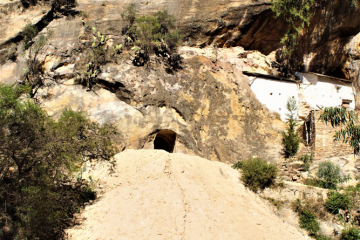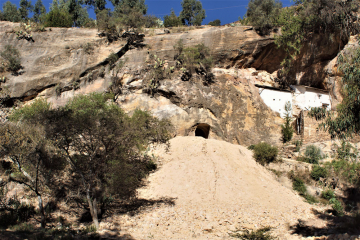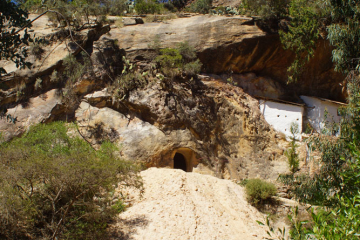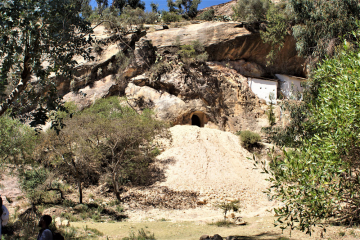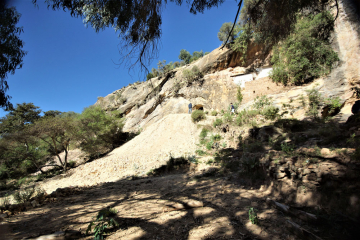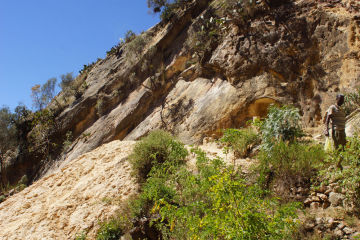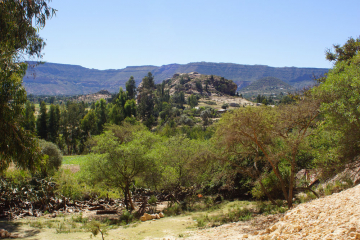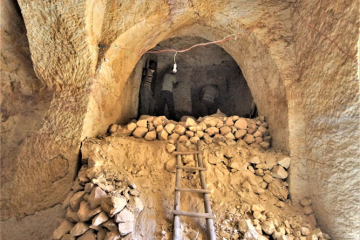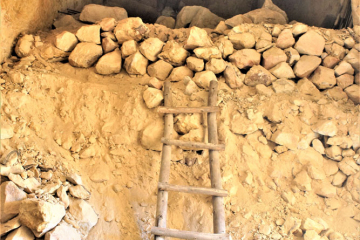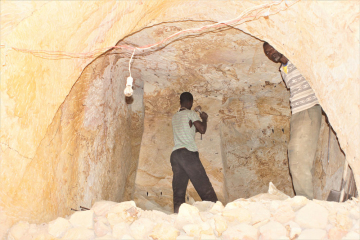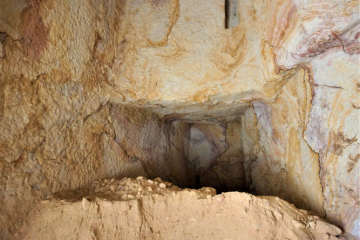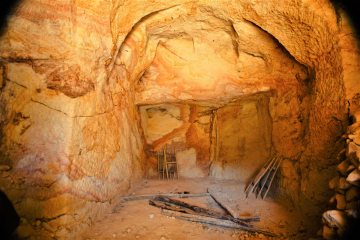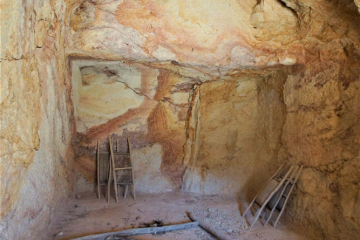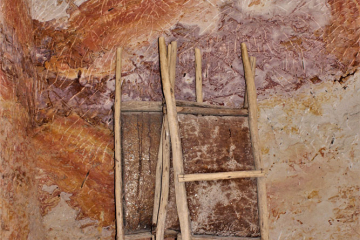Co-ordinates: 14° 15' 36" N, 39° 29' 12" E
Location:
Abunä Zär’a Abruk Nəḥəbi lies southeast of ‘Addigrat on the edge of town. The new church is carved into the east face below and to the left of the small old church of Abunä Zär’a Abruk, which is built against the cliff.
Church Description:
The responsible priest is Abba Zeri’u Gäbrä, who initiated the project and has been collecting money from the local community. The tabot will be transferred to the new church when it is complete, and the old church will then form an additional prayer chamber.
Excavation began in March 2018 (Gregorian Calendar), and the church is anticipated to include four columns and measure some twenty metres in width, twenty-five metres in length and six metres in height. The church presently consists of three bays to the east and a large central bay to the west. A tall, arched entrance gives access to the central east bay from the east. This central bay includes an arch to the north, south and west bay, that to the west being significantly wider. The ceiling of each bay is flat and there are no carved patterns or engravings. The arches overhead indicate the location of the two columns opposite the entrance, although these are yet to be entirely freed from the mother rock.
As at Maryam Šǝwito, the craftsmen have opted to work from the bottom-up. On the first visit four craftsmen were found perched on two-and-a-half metres of slag eagerly carving overhead. The slag filled most of the entrance and reduced the three east bays to a height of two metres. The infancy of this church and excavation of the nave ceiling revealed a technique previously unidentified: the craftsmen chisel one metre high vertical channels about a metre apart, which are then joined at the top by a horizontal channel. This enables the removal of large pieces of stone which break as they crash to the ground. This method is effective in speeding up excavation of vast spaces such as the aisles and nave. In top-to-bottom excavation, the rock is excavated in far smaller pieces and therefore the task takes longer.
On the second visit, three craftsmen were found hard at work. The extent of the church had changed little since the previous visit; however, much of the slag had been removed to reveal a church with a height of four-and-a-half metres (compared to two-metres on the first visit). There was still a ‘mountain’ of slag in the north east bay where the craftsmen were working overhead. The church, presently thirteen metres wide and seven-and-a-half metres deep, is still far from being complete and if funds allow, will be increased to a height of five-and-a-half metres.
Only one of the craftsmen, Ḥagos Gäbräkidan, has previous experience. Ḥagos is from Ḥawzen and previously worked at Maryam Mawka, Rafael Tsumor and finally Maryam Šǝwito . The other three craftsman are from around the church. The creation of the first new rock church in the ‘Addigrat area, and the ‘imported’ Master Craftsman and upskilling of local labourers, suggests rock churches are becoming increasingly popular and that the craft will likely spread to other areas as the need for new churches arises (particularly in the mountainous regions of Amhara and Tǝgray ).
Getting There:
The church lies east of the road from ‘Addigrat to ʿƎdaga Ḥamus. The turnoff is opposite the built church of Abrəha Aṣbəḥa on the edge of ‘Addigrat. From the turnoff it is a five-minute drive toward the built church of Qǝddus Mika’el, which sits on top of the mountain and is also visible from the main road. The new church is a ten-minute walk below Qǝddus Mikaˀel There is a second track which arrives below the new church, but still requires a short walk.
Dates Visited:
- 08 August 2019
- 16 January 2020
A Conversation with Zeri'u Gäbrä Ḥagos and Ḥagos Gäbräkidan
Abunä Zär'a Buruk
'Addigrat, Təgray, Ethiopia
January 16, 2018
(please note: caption language can be selected under the "Settings" section in the video player)
Images
(Please click to enlarge)
Architectural Drawings
(by Bayenew Kebede)
(by Tarn Philipp)
Elevation Drawings
(by Tarn Philipp)
- Abuna Zara Abruk Nehebi _ELE_2019.pdf
- Abuna Zara Abruk Nehebi _ELE_2020.pdf
- Abuna Zara Abruk Nehebi _SEC_AA_2019.pdf
- Abuna Zara Abruk Nehebi _SEC_AA_2020.pdf
- Abuna Zara Abruk Nehebi _SEC_BB_2019.pdf
- Abuna Zara Abruk Nehebi _SEC_BB_2020.pdf
- Abuna Zara Abruk Nehebi _SEC_CC_2019.pdf
- Abuna Zara Abruk Nehebi _SEC_CC_2020.pdf
- Abuna Zara Abruk Nehebi _SEC_DD_2019.pdf
- Abuna Zara Abruk Nehebi _SEC_DD_2020.pdf
